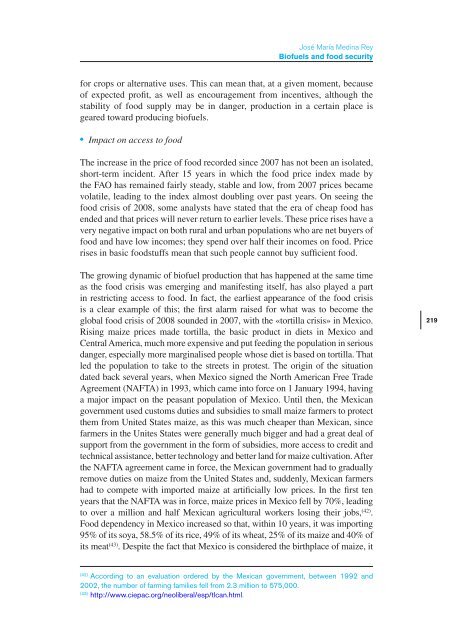Food security and global security - IEEE
Food security and global security - IEEE
Food security and global security - IEEE
- No tags were found...
You also want an ePaper? Increase the reach of your titles
YUMPU automatically turns print PDFs into web optimized ePapers that Google loves.
José María Medina ReyBiofuels <strong>and</strong> food <strong>security</strong>for crops or alternative uses. This can mean that, at a given moment, becauseof expected profit, as well as encouragement from incentives, although thestability of food supply may be in danger, production in a certain place isgeared toward producing biofuels.• Impact on access to foodThe increase in the price of food recorded since 2007 has not been an isolated,short-term incident. After 15 years in which the food price index made bythe FAO has remained fairly steady, stable <strong>and</strong> low, from 2007 prices becamevolatile, leading to the index almost doubling over past years. On seeing thefood crisis of 2008, some analysts have stated that the era of cheap food hasended <strong>and</strong> that prices will never return to earlier levels. These price rises have avery negative impact on both rural <strong>and</strong> urban populations who are net buyers offood <strong>and</strong> have low incomes; they spend over half their incomes on food. Pricerises in basic foodstuffs mean that such people cannot buy sufficient food.The growing dynamic of biofuel production that has happened at the same timeas the food crisis was emerging <strong>and</strong> manifesting itself, has also played a partin restricting access to food. In fact, the earliest appearance of the food crisisis a clear example of this; the first alarm raised for what was to become the<strong>global</strong> food crisis of 2008 sounded in 2007, with the «tortilla crisis» in Mexico.Rising maize prices made tortilla, the basic product in diets in Mexico <strong>and</strong>Central America, much more expensive <strong>and</strong> put feeding the population in seriousdanger, especially more marginalised people whose diet is based on tortilla. Thatled the population to take to the streets in protest. The origin of the situationdated back several years, when Mexico signed the North American Free TradeAgreement (NAFTA) in 1993, which came into force on 1 January 1994, havinga major impact on the peasant population of Mexico. Until then, the Mexicangovernment used customs duties <strong>and</strong> subsidies to small maize farmers to protectthem from United States maize, as this was much cheaper than Mexican, sincefarmers in the Unites States were generally much bigger <strong>and</strong> had a great deal ofsupport from the government in the form of subsidies, more access to credit <strong>and</strong>technical assistance, better technology <strong>and</strong> better l<strong>and</strong> for maize cultivation. Afterthe NAFTA agreement came in force, the Mexican government had to graduallyremove duties on maize from the United States <strong>and</strong>, suddenly, Mexican farmershad to compete with imported maize at artificially low prices. In the first tenyears that the NAFTA was in force, maize prices in Mexico fell by 70%, leadingto over a million <strong>and</strong> half Mexican agricultural workers losing their jobs, (42) .<strong>Food</strong> dependency in Mexico increased so that, within 10 years, it was importing95% of its soya, 58.5% of its rice, 49% of its wheat, 25% of its maize <strong>and</strong> 40% ofits meat (43) . Despite the fact that Mexico is considered the birthplace of maize, it219(42)According to an evaluation ordered by the Mexican government, between 1992 <strong>and</strong>2002, the number of farming families fell from 2.3 million to 575,000.(43)http://www.ciepac.org/neoliberal/esp/tlcan.html.
















